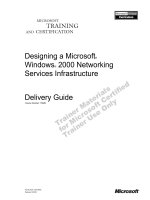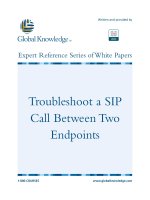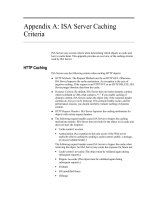Tài liệu Troubleshoot a SIP Call Between Two Endpoints pptx
Bạn đang xem bản rút gọn của tài liệu. Xem và tải ngay bản đầy đủ của tài liệu tại đây (68.89 KB, 15 trang )
Troubleshoot a SIP
Call Between Two
Endpoints
1-800-COURSES
www.globalknowledge.com
Expert Reference Series of White Papers
Written and provided by
Table of Contents
Troubleshoot a SIP Call Between Two Endpoints 1
Document ID: 69467 1
Introduction 1
Prerequisites 1
Requirements 1
Components Used 1
Conventions 1
Configure 1
Network Diagram 2
Configurations 2
Verify 3
Troubleshoot 3
NetPro Discussion Forums − Featured Conversations 11
Related Information 12
Cisco − Troubleshoot a SIP Call Between Two Endpoints
i
Troubleshoot a SIP Call Between Two Endpoints
Document ID: 69467
Introduction
Prerequisites
Requirements
Components Used
Conventions
Configure
Network Diagram
Configurations
Verify
Troubleshoot
NetPro Discussion Forums − Featured Conversations
Related Information
Introduction
This document provides a sample configuration of two fax machines in order to demonstrate how a Session
Initiation Protocol (SIP) call takes place between two gateways. This document also provides an explanation
on the output of the debug ccsip messages command for troubleshooting SIP call failures.
Prerequisites
Requirements
There are no specific requirements for this document.
Components Used
The information in this document is based on these software and hardware versions:
Two fax machines•
VG224 that runs Cisco IOS® Software Release 12.4(4)T1•
Cisco 3745 router that runs Cisco IOS Software Release 12.3(11)T8•
The information in this document was created from the devices in a specific lab environment. All of the
devices used in this document started with a cleared (default) configuration. If your network is live, make sure
that you understand the potential impact of any command.
Conventions
Refer to Cisco Technical Tips Conventions for more information on document conventions.
Configure
In this section, you are presented with the information to configure the features described in this document.
Cisco − Troubleshoot a SIP Call Between Two Endpoints
Note: Use the Command Lookup Tool (
registered customers only
) to find more information on the commands
used in this document.
Network Diagram
This document uses this network setup:
Configurations
This document uses these configurations:
VG224•
Cisco 3745•
VG224
vg224#show run
Building configuration
!
voice call send−alert
voice rtp send−recv
!
voice service pots
!
voice service voip
fax protocol t38 ls−redundancy 0 hs−redundancy 0 fallback cisco
sip
bind control source−interface FastEthernet0/0
bind media source−interface FastEthernet0/0
!
voice−port 2/0
idle−voltage low
!
dial−peer voice 1 pots
<fax machine connected to this port>
destination−pattern 9000
port 2/0
!
dial−peer voice 100 voip
destination−pattern 8000
no modem passthrough
session protocol sipv2
session target ipv4:172.16.184.83
Cisco − Troubleshoot a SIP Call Between Two Endpoints
incoming called−number .
codec g711ulaw
fax protocol t38 ls−redundancy 0 hs−redundancy 0 fallback cisco
!
Cisoc 3745
HTTS−VRK1−3745−1#show run
Building configuration
!
voice service voip
sip
bind control source−interface FastEthernet0/0
bind media source−interface FastEthernet0/0
!
!
voice−port 4/1/0
!
!
dial−peer voice 9000 voip
destination−pattern 9000
session protocol sipv2
session target ipv4:172.16.13.87
incoming called−number .
codec g711ulaw
fax protocol t38 ls−redundancy 0 hs−redundancy 0 fallback cisco
no vad
!
dial−peer voice 9 pots
destination−pattern 8000
fax rate voice
port 4/1/0
forward−digits all
Verify
There is currently no verification procedure available for this configuration.
Troubleshoot
Use this section to troubleshoot your configuration.
The Output Interpreter Tool (
registered customers only
) (OIT) supports certain show commands. Use the OIT to
view an analysis of show command output.
Note: Refer to Important Information on Debug Commands before you use debug commands.
This is the output of the debug ccsip messages command:
!−−− This is the first invite message sent out
!−−− to the terminating SIP gateway.
!−−− This is similar to a setup message in H.323 or Q.931.
*Mar 1 00:33:42.419: //−1/xxxxxxxxxxxx/SIP/Msg/ccsipDisplayMsg:
Sent:
INVITE sip::5060 SIP/2.0
Cisco − Troubleshoot a SIP Call Between Two Endpoints
!−−− 8000 is the DN of the call, 172.16.184.83 is
!−−− the IP address of the remote gateway, and
!−−− 5060 is the port the SIP works on.
!−−− This configuration uses SIP version 2.0.
Via: SIP/2.0/UDP 172.16.13.87:5060;branch=z9hG4bKB21AF
!−−− The VIA field is used for devices in the patch that
!−−− need to be aware of the call.
!−−− In this case, there are no SIP devices in between the two gateways.
Remote−Party−ID: <sip:>;party=calling;screen=no;privacy=off
!−−− The DN and URI of the remote SIP device that is called.
From: <sip:>;tag=1EDC10−2436
To: <sip:>
Date: Fri, 01 Mar 2002 00:33:42 GMT
!−−− The time that the invite is sent out
Call−ID: D110EA36−2BE211D6−801CEF21−
!−−− The call ID is unique for every call.
!−−− This ID is used to identify a particular call
!−−− in a busy router.
Supported: 100rel,timer,resource−priority,replaces
Min−SE: 1800
Cisco−Guid: 3481906499−736235990−2149183265−3714191467
User−Agent: Cisco−SIPGateway/IOS−12.x
Allow: INVITE, OPTIONS, BYE, CANCEL, ACK, PRACK, UPDATE, REFER,
SUBSCRIBE, NOTIFY, INFO, REGISTER
CSeq: 101 INVITE
!−−− The sequence number for each transaction.
Max−Forwards: 70
Timestamp: 1014942822
Contact: <sip::5060>
!−−− This is the address used to reach the calling party on the return path.
Expires: 180
!−−− This message expires in 180 seconds.
Allow−Events: telephone−event
Content−Type: application/sdp
Content−Disposition: session;handling=required
Content−Length: 215
v=0
!−−− The Session Descriptor Protocol (SDP) version is zero.
!−−− This is different from the SIP version used
!−−− in this example configuration.
o=CiscoSystemsSIP−GW−UserAgent 1715 2724 IN IP4 172.16.13.87
!−−− The owner of the device that created the call.
!−−− This is sometimes referred to as organization.
s=SIP Call
Cisco − Troubleshoot a SIP Call Between Two Endpoints
!−−− The name given to this particular SIP call. This is the description.
c=IN IP4 172.16.13.87
!−−− Connection information. Usually includes the IP address of
!−−− the originating device. It is an optional field.
t=0 0
m=audio 18080 RTP/AVP 0 19
!−−− This is the media information. In this case,
!−−− 18080 is used as the UDP port for RTP.
c=IN IP4 172.16.13.87
a=rtpmap:0 PCMU/8000
!−−− This is the media attributes. Notice the 0 and 19 in
!−−− the media field. These are the
!−−− attributes that go with that. PCMU/8000 is G711ulaw.
a=rtpmap:19 CN/8000
a=ptime:20
!−−− A packetization period of 20 ms.
!−−− In this output, invite, SDP is not a required parameter.
!−−− But in this case you see that SDP sent out.
!−−− SDP carries information about capabilities.
!−−− No information about fax capabilities are
!−−− exchanged in the beginning because it is only a voice
!−−− call until you hear fax tones from the terminating fax machine.
*Mar 1 00:33:43.203: //−1/xxxxxxxxxxxx/SIP/Msg/ccsipDisplayMsg:
Received:
SIP/2.0 100 Trying
Via: SIP/2.0/UDP 172.16.13.87:5060;branch=z9hG4bKB21AF
From: <sip:>;tag=1EDC10−2436
To: <sip:>;tag=85E9C7C8−A4C
Date: Tue, 28 Feb 2006 23:43:36 GMT
Call−ID: D110EA36−2BE211D6−801CEF21−
Timestamp: 1014942822
Server: Cisco−SIPGateway/IOS−12.x
CSeq: 101 INVITE
Allow−Events: telephone−event
Content−Length: 0
!−−− The terminating machine sets up an analog
!−−− connection to the fax machine, and while it waits,
!−−− it sends a "trying" message. This stops the
!−−− originating gateway from sending another invite.
*Mar 1 00:33:43.207: //−1/xxxxxxxxxxxx/SIP/Msg/ccsipDisplayMsg:
Received:
SIP/2.0 183 Session Progress
Via: SIP/2.0/UDP 172.16.13.87:5060;branch=z9hG4bKB21AF
From: <sip:>;tag=1EDC10−2436
To: <sip:>;tag=85E9C7C8−A4C
Date: Tue, 28 Feb 2006 23:43:36 GMT
Cisco − Troubleshoot a SIP Call Between Two Endpoints
Call−ID: D110EA36−2BE211D6−801CEF21−
Timestamp: 1014942822
Server: Cisco−SIPGateway/IOS−12.x
CSeq: 101 INVITE
Require: 100rel
RSeq: 3696
Allow: INVITE, OPTIONS, BYE, CANCEL, ACK, PRACK, COMET, REFER, SUBSCRIBE,
NOTIFY, INFO, UPDATE, REGISTER
Allow−Events: telephone−event
Contact: <sip::5060>
Content−Disposition: session;handling=required
Content−Type: application/sdp
Content−Length: 194
v=0
o=CiscoSystemsSIP−GW−UserAgent 7643 2735 IN IP4 172.16.184.83
s=SIP Call
c=IN IP4 172.16.184.83
t=0 0
m=audio 18304 RTP/AVP 0
!−−− This is a different UDP port for the reverse direction.
c=IN IP4 172.16.184.83
a=rtpmap:0 PCMU/8000
a=ptime:20
!−−− A "progress" indicator tells you that the remote gateway sent a connect
!−−− and the fax machine is ringing at this time.
!−−− Note that the To and From headers do not change despite
!−−− the fact that the message comes in the opposite direction.
*Mar 1 00:33:43.211: //−1/xxxxxxxxxxxx/SIP/Msg/ccsipDisplayMsg:
Received:
SIP/2.0 183 Session Progress
Via: SIP/2.0/UDP 172.16.13.87:5060;branch=z9hG4bKB21AF
From: <sip:>;tag=1EDC10−2436
To: <sip:>;tag=85E9C7C8−A4C
Date: Tue, 28 Feb 2006 23:43:36 GMT
Call−ID: D110EA36−2BE211D6−801CEF21−
Timestamp: 1014942822
Server: Cisco−SIPGateway/IOS−12.x
CSeq: 101 INVITE
Require: 100rel
RSeq: 3696
Allow: INVITE, OPTIONS, BYE, CANCEL, ACK, PRACK, COMET, REFER, SUBSCRIBE,
NOTIFY, INFO, UPDATE, REGISTER
Allow−Events: telephone−event
Contact: <sip::5060>
Content−Disposition: session;handling=required
Content−Type: application/sdp
Content−Length: 194
v=0
o=CiscoSystemsSIP−GW−UserAgent 7643 2735 IN IP4 172.16.184.83
s=SIP Call
c=IN IP4 172.16.184.83
t=0 0
m=audio 18304 RTP/AVP 0
c=IN IP4 172.16.184.83
a=rtpmap:0 PCMU/8000
a=ptime:20
Cisco − Troubleshoot a SIP Call Between Two Endpoints
!−−− A provisional ack to the progress message.
*Mar 1 00:33:43.251: //−1/xxxxxxxxxxxx/SIP/Msg/ccsipDisplayMsg:
Sent:
PRACK sip::5060 SIP/2.0
Via: SIP/2.0/UDP 172.16.13.87:5060;branch=z9hG4bKC384
From: <sip:>;tag=1EDC10−2436
To: <sip:>;tag=85E9C7C8−A4C
Date: Fri, 01 Mar 2002 00:33:42 GMT
Call−ID: D110EA36−2BE211D6−801CEF21−
CSeq: 102 PRACK
RAck: 3696 101 INVITE
Max−Forwards: 70
Content−Length: 0
!−−− This is an OK for the PRACK. You can tell this from the Cseq header.
*Mar 1 00:33:44.031: //−1/xxxxxxxxxxxx/SIP/Msg/ccsipDisplayMsg:
Received:
SIP/2.0 200 OK
Via: SIP/2.0/UDP 172.16.13.87:5060;branch=z9hG4bKC384
From: <sip:>;tag=1EDC10−2436
To: <sip:>;tag=85E9C7C8−A4C
Date: Tue, 28 Feb 2006 23:43:37 GMT
Call−ID: D110EA36−2BE211D6−801CEF21−
Server: Cisco−SIPGateway/IOS−12.x
CSeq: 102 PRACK
Content−Length: 0
!−−− An OK is received, which is mandatory for an invite.
!−−− The OK has information on the accepted media parameters in the SDP.
*Mar 1 00:33:49.431: //−1/xxxxxxxxxxxx/SIP/Msg/ccsipDisplayMsg:
Received:
SIP/2.0 200 OK
Via: SIP/2.0/UDP 172.16.13.87:5060;branch=z9hG4bKB21AF
From: <sip:>;tag=1EDC10−2436
To: <sip:>;tag=85E9C7C8−A4C
Date: Tue, 28 Feb 2006 23:43:37 GMT
Call−ID: D110EA36−2BE211D6−801CEF21−
Timestamp: 1014942822
Server: Cisco−SIPGateway/IOS−12.x
CSeq: 101 INVITE
Allow: INVITE, OPTIONS, BYE, CANCEL, ACK, PRACK, COMET, REFER, SUBSCRIBE,
NOTIFY, INFO, UPDATE, REGISTER
Allow−Events: telephone−event
Contact: <sip::5060>
Content−Type: application/sdp
Content−Length: 194
v=0
o=CiscoSystemsSIP−GW−UserAgent 7643 2735 IN IP4 172.16.184.83
s=SIP Call
c=IN IP4 172.16.184.83
t=0 0
m=audio 18304 RTP/AVP 0
c=IN IP4 172.16.184.83
Cisco − Troubleshoot a SIP Call Between Two Endpoints
a=rtpmap:0 PCMU/8000
a=ptime:20
!−−− The ack for the OK.
*Mar 1 00:33:49.443: //−1/xxxxxxxxxxxx/SIP/Msg/ccsipDisplayMsg:
Sent:
ACK sip::5060 SIP/2.0
Via: SIP/2.0/UDP 172.16.13.87:5060;branch=z9hG4bKD1A5C
From: <sip:>;tag=1EDC10−2436
To: <sip:>;tag=85E9C7C8−A4C
Date: Fri, 01 Mar 2002 00:33:42 GMT
Call−ID: D110EA36−2BE211D6−801CEF21−
Max−Forwards: 70
CSeq: 101 ACK
Content−Length: 0
!−−− At this point, the terminating gateway hears fax tones and determines it
!−−− has to switch the codec to a
!−−− fax codec and sends a re−invite. The re−invite contains
!−−− information about the new media
!−−− parameters that the terminating gateway wants to change to.
*Mar 1 00:33:55.247: //−1/xxxxxxxxxxxx/SIP/Msg/ccsipDisplayMsg:
Received:
INVITE sip::5060 SIP/2.0
Via: SIP/2.0/UDP 172.16.184.83:5060;branch=z9hG4bK1A735
From: <sip:>;tag=85E9C7C8−A4C
To: <sip:>;tag=1EDC10−2436
Date: Tue, 28 Feb 2006 23:43:49 GMT
Call−ID: D110EA36−2BE211D6−801CEF21−
Supported: 100rel,timer
Min−SE: 1800
Cisco−Guid: 3481906499−736235990−2149183265−3714191467
User−Agent: Cisco−SIPGateway/IOS−12.x
Allow: INVITE, OPTIONS, BYE, CANCEL, ACK, PRACK, COMET, REFER, SUBSCRIBE,
NOTIFY, INFO, UPDATE, REGISTER
CSeq: 101 INVITE
Max−Forwards: 70
Timestamp: 1141170229
Contact: <sip::5060>
Expires: 180
Allow−Events: telephone−event
Content−Type: application/sdp
Content−Length: 399
v=0
o=CiscoSystemsSIP−GW−UserAgent 7643 2736 IN IP4 172.16.184.83
s=SIP Call
c=IN IP4 172.16.184.83
t=0 0
m=image 18304 udptl t38
c=IN IP4 172.16.184.83
a=T38FaxVersion:0
a=T38MaxBitRate:14400
!−−− The maximum bit rate that is supported by the terminating gateway.
a=T38FaxFillBitRemoval:0
a=T38FaxTranscodingMMR:0
Cisco − Troubleshoot a SIP Call Between Two Endpoints
a=T38FaxTranscodingJBIG:0
a=T38FaxRateManagement:transferredTCF
a=T38FaxMaxBuffer:200
a=T38FaxMaxDatagram:72
a=T38FaxUdpEC:t38UDPRedundancy
!−−− UDP redundancy is enabled.
!−−− A trying message is sent and an
!−−− attempt is made to determine if T.38 fax−relay is supported.
*Mar 1 00:33:55.275: //−1/xxxxxxxxxxxx/SIP/Msg/ccsipDisplayMsg:
Sent:
SIP/2.0 100 Trying
Via: SIP/2.0/UDP 172.16.184.83:5060;branch=z9hG4bK1A735
From: <sip:>;tag=85E9C7C8−A4C
To: <sip:>;tag=1EDC10−2436
Date: Fri, 01 Mar 2002 00:33:55 GMT
Call−ID: D110EA36−2BE211D6−801CEF21−
Server: Cisco−SIPGateway/IOS−12.x
CSeq: 101 INVITE
Allow−Events: telephone−event
Remote−Party−ID: <sip:>;party=called;screen=no;privacy=off
Content−Length: 0
!−−− The OK to the re−invite that specifies that you can
!−−− do T.38 fax−relay. The same UDP port is retained.
*Mar 1 00:33:55.275: //−1/xxxxxxxxxxxx/SIP/Msg/ccsipDisplayMsg:
Sent:
SIP/2.0 200 OK
Via: SIP/2.0/UDP 172.16.184.83:5060;branch=z9hG4bK1A735
From: <sip:>;tag=85E9C7C8−A4C
To: <sip:>;tag=1EDC10−2436
Date: Fri, 01 Mar 2002 00:33:55 GMT
Call−ID: D110EA36−2BE211D6−801CEF21−
Server: Cisco−SIPGateway/IOS−12.x
CSeq: 101 INVITE
Allow: INVITE, OPTIONS, BYE, CANCEL, ACK, PRACK, UPDATE, REFER, SUBSCRIBE,
NOTIFY, INFO, REGISTER
Allow−Events: telephone−event
Remote−Party−ID: <sip:>;party=called;screen=no;privacy=off
Contact: <sip::5060>
Content−Type: application/sdp
Content−Length: 157
v=0
o=CiscoSystemsSIP−GW−UserAgent 1715 2725 IN IP4 172.16.13.87
s=SIP Call
c=IN IP4 172.16.13.87
t=0 0
m=image 18080 udptl t38
c=IN IP4 172.16.13.87
!−−− The ack to the OK is received. At this point, fax transmission occurs.
*Mar 1 00:33:55.719: //−1/xxxxxxxxxxxx/SIP/Msg/ccsipDisplayMsg:
Cisco − Troubleshoot a SIP Call Between Two Endpoints
Received:
ACK sip::5060 SIP/2.0
Via: SIP/2.0/UDP 172.16.184.83:5060;branch=z9hG4bK1B21D0
From: <sip:>;tag=85E9C7C8−A4C
To: <sip:>;tag=1EDC10−2436
Date: Tue, 28 Feb 2006 23:43:49 GMT
Call−ID: D110EA36−2BE211D6−801CEF21−
Max−Forwards: 70
CSeq: 101 ACK
Content−Length: 0
!−−− Once the fax transmission is completed,
!−−− the BYE is received. The BYE is similar to a
!−−− release message in Q.931.
*Mar 1 00:34:45.515: //−1/xxxxxxxxxxxx/SIP/Msg/ccsipDisplayMsg:
Received:
BYE sip::5060 SIP/2.0
Via: SIP/2.0/UDP 172.16.184.83:5060;branch=z9hG4bK1E1E51
From: <sip:>;tag=85E9C7C8−A4C
To: <sip:>;tag=1EDC10−2436
Date: Tue, 28 Feb 2006 23:44:38 GMT
Call−ID: D110EA36−2BE211D6−801CEF21−
User−Agent: Cisco−SIPGateway/IOS−12.x
Max−Forwards: 70
Timestamp: 1141170279
CSeq: 103 BYE
Reason: Q.850;cause=16
!−−− Cause code 16 is a normal disconnect cause.
Content−Length: 0
!−−− There should be an OK to every message.
*Mar 1 00:34:45.535: //−1/xxxxxxxxxxxx/SIP/Msg/ccsipDisplayMsg:
Sent:
SIP/2.0 200 OK
Via: SIP/2.0/UDP 172.16.184.83:5060;branch=z9hG4bK1E1E51
From: <sip:>;tag=85E9C7C8−A4C
To: <sip:>;tag=1EDC10−2436
Date: Fri, 01 Mar 2002 00:34:45 GMT
Call−ID: D110EA36−2BE211D6−801CEF21−
Server: Cisco−SIPGateway/IOS−12.x
Timestamp: 1141170279
CSeq: 103 BYE
Reason: Q.850;cause=16
Content−Length: 0
More information about the attributes:
Session description
v= (protocol version)
o= (owner/creator and session identifier).
s= (session name)
i=* (session information)
u=* (URI of description)
e=* (email address)
p=* (phone number)
c=* (connection information − not required if included in all media)
b=* (bandwidth information)
Cisco − Troubleshoot a SIP Call Between Two Endpoints
z=* (time zone adjustments)
k=* (encryption key)
a=* (zero or more session attribute lines)
Time description
t= (time the session is active)
r=* (zero or more repeat times)
Media description
m= (media name and transport address)
i=* (media title)
c=* (connection information − optional if included at session−level)
b=* (bandwidth information)
k=* (encryption key)
a=* (zero or more media attribute lines)
* indicated optional item.
Basic Requests
INVITE: request from a UAC to initiate a session
ACK: confirms receipt of a final response to INVITE
BYE: sent by either side to end a session
CANCEL: sent to end a call not yet connected
UPDATE: Updates offer for not−yet−established sessions.
REGISTER: UA registers with Registrar Server
NOTIFY: notifies that an event has occurred
REFER: the mechanism to initiate a session transfer
INFO: a means of carrying ?data? in a message body
SIP responses:
1xx: Provisional ? request received, continuing to process the request
2xx: Success − action was successfully received, understood, and accepted
3xx: Redirection − further action needs to be taken in order to complete the request
4xx: Client Error − the request contains bad syntax or cannot be
fulfilled at this server
5xx: Server Error − the server failed to fulfill an apparently valid request
6xx: Global Failure − the request cannot be fulfilled at any server
NetPro Discussion Forums − Featured Conversations
Networking Professionals Connection is a forum for networking professionals to share questions, suggestions,
and information about networking solutions, products, and technologies. The featured links are some of the
most recent conversations available in this technology.
NetPro Discussion Forums − Featured Conversations for Voice
Service Providers: Voice over IP
Voice & Video: Voice over IP
Voice & Video: IP Telephony
Voice & Video: IP Phone Services for End Users
Voice & Video: Unified Communications
Voice & Video: IP Phone Services for Developers
Voice & Video: General
Cisco − Troubleshoot a SIP Call Between Two Endpoints
Related Information
SDP RFC 2327•
SIP RFC 3261•
Voice Technology Support•
Voice and IP Communications Product Support•
Recommended Reading: Troubleshooting Cisco IP Telephony•
Technical Support & Documentation − Cisco Systems•
All contents are Copyright © 1992−2006 Cisco Systems, Inc. All rights reserved. Important Notices and Privacy Statement.
Updated: Apr 27, 2006 Document ID: 69467
Cisco − Troubleshoot a SIP Call Between Two Endpoints
Learn More
Learn more about how you can improve productivity, enhance efficiency, and sharpen your competitive edge.
Check out the following Global Knowledge courses:
Voice over IP Foundations
ACCMU (Administering Cisco CallManager and Unity v5.0
CIPT1 (Cisco IP Telephony Part 1 v.4.1)
For more information or to register, visit www.globalknowledge.com or call 1-800-COURSES to speak with a
sales representative.
Our courses and enhanced, hands-on labs offer practical skills and tips that you can immediately put to use.
Our expert instructors draw upon their experiences to help you understand key concepts and how to apply
them to your specific work situation. Choose from our more than 700 courses, delivered through Classrooms,
e-Learning, and On-site sessions, to meet your IT and management training needs.
Copyright ©2006 Cisco Systems, Inc. All rights reserved.
Page









